THIS PRODUCT IS OBSOLETE. Show more about end-life-products policy.
Recommended product:
Product:
M2i.4031
14 bit multi-purpose digitizer
Description:
The M2i.40xx series is best suitable for applications that need high sampling rates as well as a maximum signal dynamic. These boards offer a resolution four times higher than 12 bit boards. On the M2i.40xx every channel has its own amplifier and A/D converter. Each input channel can be adapted to a wide variety of signal sources. This is done by software selecting a matching input range, an input impedance and an individual input offset compensation. The user will easily find a matching solution from the six offered models. These versions are working with sampling rates of 20 MS/s or 50 MS/s and have one, two or four channels. They can also be updated to a multichannel system using the synchronization option. Data is written in the internal 128 MSample up to 1 GSample large memory. All boards of the M2i.40xx series may use the whole installed on-board memory completely for the currently activated number of channels. This memory can also be used as a FIFO buffer. In FIFO mode data can be transferred on-line directly into the PC RAM or to hard disk.
Facts & Features:
- Up to 50 MS/s on 2 channels
- Simultaneously sampling on all channels
- Separate ADC and amplifier per channel
- Programmable input offset of ±200%
- Up to 1 GSample on-board memory
- 256 MSample standard memory installed
- 6 input ranges: +/-200 mV up to +/-10 V
- Window, pulse width, re-arm, OR/AND trigger
- Synchronization of up to 16 cards
- 66 MHz 32 bit PCI-X interface
- 5V / 3.3V PCI compatible
- 100% compatible to conventional PCI >= V2.1
- Sustained streaming mode up to 245 MB/s
Application examples:
- Explosion Tests
- Ignition Voltage Tests
- Combustion optimization
- IQ Base Signal Acquisition
- NMR (Nuclear Magnetic Resonance)

BaseXIO (Optional)
The BaseXIO option offers 8 asynchronous digital I/O lines on the base card. The direction can be selected by software in groups of four. Two of these lines can also be used as additional external trigger sources. This allows the building of complex trigger conjunctions with external gated triggers as well as AND/OR conjunction of multiple external trigger sources like, for example, the picture and row synchronisation of video signals. In addition one of the I/O lines can be used as reference clock for the Timestamp counter.

FIFO mode
The FIFO mode is designed for continuous data transfer between measurement board and PC memory (up to 245 MB/s on a PCI-X slot, up to 125 MB/s on a PCI slot and up to 160 MB/s on a PCIe slot) or hard disk. The control of the data stream is done automatically by the driver on interrupt request. The complete installed on-board memory is used for buffer data, making the continuous streaming extremely reliable.
System Star-Hub (Optional)
Using the System Star-Hub for M2i series cards it is possible to synchronize several systems with each other having the same advantages that the standard Star-Hub gives. The system star-hub allows to extend the number of synchronous channels or set up multiple synchronous data streaming systems either for data storage or online calculations.

Star-Hub (Optional)
The star-hub is an additional module allowing the phase stable synchronization of up to 16 boards in one system. Independent of the number of boards there is no phase delay between all channels. The star-hub distributes trigger and clock information between all boards. As a result all connected boards are running with the same clock and the same trigger. All trigger sources can be combined with OR/AND allowing all channels of all cards to be trigger source at the same time. The star-hub is available as 5 card and 16 card version. The 5 card version doesn't need an extra slot.
The ABA mode combines slow continuous data recording with fast acquisition on trigger events. The ABA mode works like a slow data logger combined with a fast digitizer. The exact position of the trigger events is stored as timestamps in an extra memory.

Channel Trigger
The data acquisition boards offer a wide variety of trigger modes. Besides the standard signal checking for level and edge as known from oscilloscopes it's also possible to define a window trigger. Trigger conditions can be combined with logical conjunctions like OR to adopt to different application scenarios.
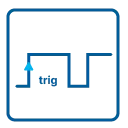
External Trigger
All boards can be triggered using an external TTL signal. It's possible to use positive or negative edge also in combination with a programmable pulse width. An internally recognized trigger event can - when activated by software - be routed to the trigger connector to start external instruments.
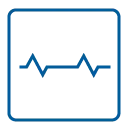


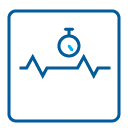
Timestamp
The timestamp option writes the time positions of the trigger events in an extra memory. The timestamps are relative to the start of recording, a defined zero time, externally synchronized to a radio clock, or a GPS receiver. With this option acquisitions of systems on different locations can be set in a precise time relation.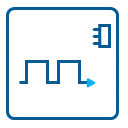
External Clock
Using a dedicated connector a sampling clock can be fed in from an external system. It's also possible to output the internally used sampling clock to synchronize external equipment to this clock.

High Precision PLL
The internal sampling clock of the card is generated using a high precision PLL. This powerful device allows to select the sampling rate with a fine step size making it possible to perfectly adopt to different measurement tasks. Most other cards on the market only allow the setup of fixed sampling rates like 100 MS/s, 50 MS/s, 25 MS/s, 10 MS/s, ... without any possibility to set the sampling rate to any value in between.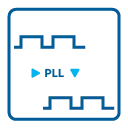
Reference Clock
The option to use a precise external reference clock (normally 10 MHz) is necessary to synchronize the board for high-quality measurements with external equipment (like a signal source). It's also possible to enhance the quality of the sampling clock in this way. The driver automatically generates the requested sampling clock from the fed in reference clock.
Digital Inputs (Optional)
This option acquires additional synchronous digital channels phase-stable with the analog data. When the option is installed and activated additional digital inputs are stored in the unused bits of each ADC word (2 digital inputs on 14 bit A/D and 4 digital inputs on 12 bit A/D)

Programmable Input Amplifiers
The analog inputs can be adapted to real world signals using a wide variety of settings that are individual for each channel. By using software commands the input termination can be changed between 50 Ohm and 1 MOhm and one can select an input range matching the real world signal.
Programmable Input Offset
Most of the Spectrum A/D cards offer a user programmable signal offset opening the Spectrum boards to a wide variety of setups. The signal offset at least covers a range of +/-100 % of the currently selected input range making unipolar measurements with the card possible. Besides this the input range offset can be programmed individually allowing a perfect match of the A/D card section to the real world signal.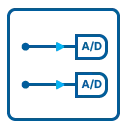
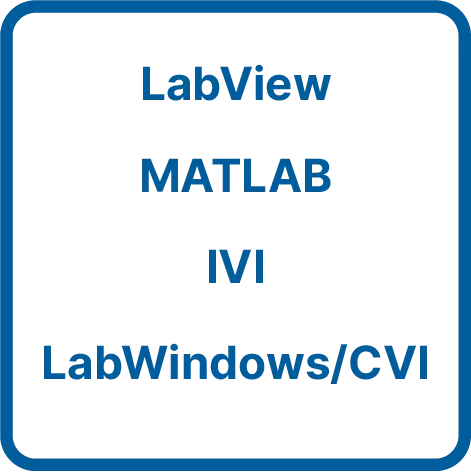



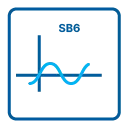

This standard driver is included in the card delivery and it is possible to get the newest driver version free of charge from our homepage at any time. There are no additional SDK fees for the classical text-based programming. All boards are delivered with drivers for Windows 7, Windows 8, Windows 10 and Windows 11, all 32 bit and 64 bit.
| Product | Channels | Max. Samplerate | Max. Bandwidth |
|---|---|---|---|
| M2i.4020 | 1 | 20 MS/s | 10 MHz |
| M2i.4021 | 2 | 20 MS/s | 10 MHz |
| M2i.4022 | 4 | 20 MS/s | 10 MHz |
| M2i.4028 | 1 | 20 MS/s | 10 MHz |
| M2i.4030 | 1 | 50 MS/s | 25 MHz |
| M2i.4032 | 4 | 50 MS/s | 25 MHz |
| M2i.4038 | 1 | 50 MS/s | 25 MHz |
| On different platforms | Bus | Max. Bus Transfer speed |
|---|---|---|
| M2i.4031-Exp | PCI Express x1 | 160 MByte/s |
| MC.4031 | CompactPCI | 100 MByte/s |
| MI.4031 | PCI | 100 MByte/s |
| MX.4031 | PXI | 100 MByte/s |


Clock / Trigger Distribution (Optional)
The Clock and Trigger Distribution card allows to externally connect several systems with a common clock and a synchronized trigger signal. One can connect up to 17 independent systems or external equipment using this card.
Docking Stations (Optional)
All Spectrum products can be used in 3rd party docking stations, connected by either PCIe interface card or by Thunderbolt interface. Docking stations can extend a standard PC by up to 16 PCIe slots.Documents
Windows driver installation of driver versions < 4.0 |
21.02.2022 | 1 M | ||
Data sheet of the M2i.40xx family |
21.02.2022 | 902 K | ||
Manual of M2i.40xx family |
21.02.2022 | 7 M | ||
Product Discontinuance Notification for M2i.40xx Series |
21.02.2022 | 234 K | ||
Datasheet of Spectrum Terastore Streaming System |
21.02.2022 | 910 K | ||
M2i Clock / Trigger distribution card |
21.02.2022 | 217 K | ||
M2i StarHub module datasheet |
21.02.2022 | 224 K | ||
Data sheet of SPA pre-amplifier |
08.12.2023 | 580 K | ||
Data sheet of Docking Station |
21.02.2022 | 166 K | ||
Short Manual for IVI Driver |
21.02.2022 | 532 K | ||
Data sheet of SBench 6 |
15.01.2024 | 999 K | ||
Manual for MATLAB driver M2p/M4i/M4x/M5i/M2i/M3i/DN2/DN6 |
13.12.2023 | 1 M | ||
Manual for LabVIEW drivers for M2i/DN2 |
21.02.2022 | 2 M | ||
Manual for SBench 6 |
21.02.2022 | 7 M |
WINDOWS DRIVER + SOFTWARE
M2i / M3i driver - last Version for Windows 2000 |
2 | 21.02.2022 | 437 K | |
M2p/M4i/M4x/M5i/M2i/M3i/DN2/DN6 driver for Windows 7, 8, 10, 11 (32/64 bit) |
7.01 | 22.04.2024 | 5 M | |
M2i/M3i/M4i/M4x driver - last Version for Windows 32 XP / Vista |
3.30 | 21.02.2022 | 2 M | |
M2i/M3i/M4i/M4x driver - last Version for Windows 64 XP / Vista |
3.20 | 21.02.2022 | 3 M | |
C/C++ driver header and library files |
7.01 | 22.04.2024 | 43 K | |
Spectrum Control Center - last Version for Windows 2000 |
1.41 | 21.02.2022 | 8 M | |
SBench 5 Installer |
5.3.0 | 21.02.2022 | 5 M | |
Spectrum Control Center (32-bit) / Windows 7, 8, 10 |
2.36 | 22.04.2024 | 22 M | |
Spectrum Control Center (64-bit) / Windows 7, 8, 10, 11 |
2.36 | 22.04.2024 | 25 M | |
Spectrum Control Center - last Version for Windows XP |
1.74 | 21.02.2022 | 8 M | |
SBench 6 (32-bit) Installer / Windows 7, 8, 10 |
6.5.08 | 22.04.2024 | 36 M | |
SBench 6 (64-bit) Installer / Windows 7, 8, 10, 11 |
6.5.08 | 22.04.2024 | 39 M | |
SBench6 - last Version for Windows XP |
6.3.5 | 21.02.2022 | 41 M | |
Windows Installer for Remote Server Option |
22.04.2024 | 13 M | ||
IVI Driver for IVI Digitizer class (32 bit) |
22.04.2024 | 3 M | ||
IVI Driver for IVI Scope class (32 bit) |
22.04.2024 | 3 M | ||
M2i/M2p/M3i/M4i/M4x/M5i/DN2/DN6 LabView driver installer |
22.04.2024 | 19 M | ||
M2p/M4i/M4x/M5i/M2i/M3i/DN2/DN6 Matlab driver + examples installer |
22.04.2024 | 15 M | ||
Windows Examples (C/C++, .NET, Delphi, Java, Python, Julia ...) |
7.01 | 22.04.2024 | 2 M |
LINUX DRIVER + SOFTWARE
M2p/M4i/M4x/M5i/M2i/M3i drivers (Kernel + Library) for Linux 32 bit and 64 bit |
7.01 | 22.04.2024 | 12 M | |
Driver libraries (no Kernel) for Linux 32 bit and 64 bit |
7.01 | 22.04.2024 | 9 M | |
Spectrum Remote Server Linux Installer Package |
22.04.2024 | 12 K | ||
Spectrum Control Center |
2.36 | 22.04.2024 | 57 M | |
SBench 6 Linux 32 (.rpm) |
6.5.08 | 22.04.2024 | 26 M | |
SBench 6 Linux 64 (.rpm) |
6.5.08 | 22.04.2024 | 26 M | |
SBench 6 Linux 32 (.deb) |
6.5.08 | 22.04.2024 | 23 M | |
SBench 6 Linux 64 (.deb) |
6.5.08 | 22.04.2024 | 22 M | |
SBench6 Jetson (.deb) |
6.5.08 | 22.04.2024 | 11 M | |
Drivers + examples for MATLAB for Linux (DEB + RPM) |
22.04.2024 | 183 K | ||
Linux Examples (C/C++, Python, Julia ...) |
7.01 | 22.04.2024 | 560 K |
Firmware
M2i/M2p/M3i/M4i/M4x/M5i firmware update (Windows) |
22.04.2024 | 22 M | ||
M2i/M2p/M3i/M4i/M4x/M5i firmware update (Linux) |
22.04.2024 | 30 M |
Case Studies
| OCT Skin Cancer Scanner | OCT application for skin cancer diagnosis |
21.02.2022 | 351 K |
Product Notes
| General Digitizer Introduction | General Introduction to Waveform Digitizers |
21.02.2022 | 587 K | |
| High-Res High BW Digitizers | Advantages of High Resolution in High Bandwidth Digitizers |
21.02.2022 | 2 M | |
| Digitizer Acquisition Modes | Using modular Digitizer Acquisition Modes |
21.02.2022 | 3 M | |
| Digitizer Front-End | Proper Use of Digitizer Front-End Signal Conditioning |
21.02.2022 | 3 M | |
| Trigger and Sync | Trigger, Clock and Synchronization Details at high-speed Digitizers |
21.02.2022 | 1 M | |
| Digitizer Software Integration | Software Support for Modular Digitizers |
21.02.2022 | 724 K | |
| SBench 6 Introduction | SBench 6 - Data Acquisition and Analysis of Digitizer Data |
21.02.2022 | 1 M |
Application Notes
| Ultrasonic Applications | Using Digitizers in Ultrasonic Applications |
21.02.2022 | 617 K | |
| Signal Processing Tools | Using Signal Processing Tools to enhance Digitizer Data |
21.02.2022 | 1 M | |
| Using Probes & Sensors | Using Probes and Sensors with Modular Digitizers |
21.02.2022 | 858 K | |
| Digitizers as Oscilloscope | Using a Digitizer as Oscilloscope |
21.02.2022 | 845 K | |
| Solving Data Transfer Bottlenecks on Digitizers | Solving Data Transfer Bottlenecks on Digitizers |
21.02.2022 | 2 M | |
| Teaming AWG with Digitizer | Teaming an Arbitrary Waveform Generator with a Modular Digitizer |
21.02.2022 | 919 K | |
| Common Digitizer Setup Problems | Application Note: Common Digitizer Setup Problems to avoid |
21.02.2022 | 1 M | |
| AN Amplitude Resolution | Application Note: The Amplitude Resolution of Digitizers and how it affects Measurements |
21.02.2022 | 555 K | |
| AN008 Install Legacy Win Drivers | Application Note: Legacy Windows Driver Installation |
21.02.2022 | 1 M |


